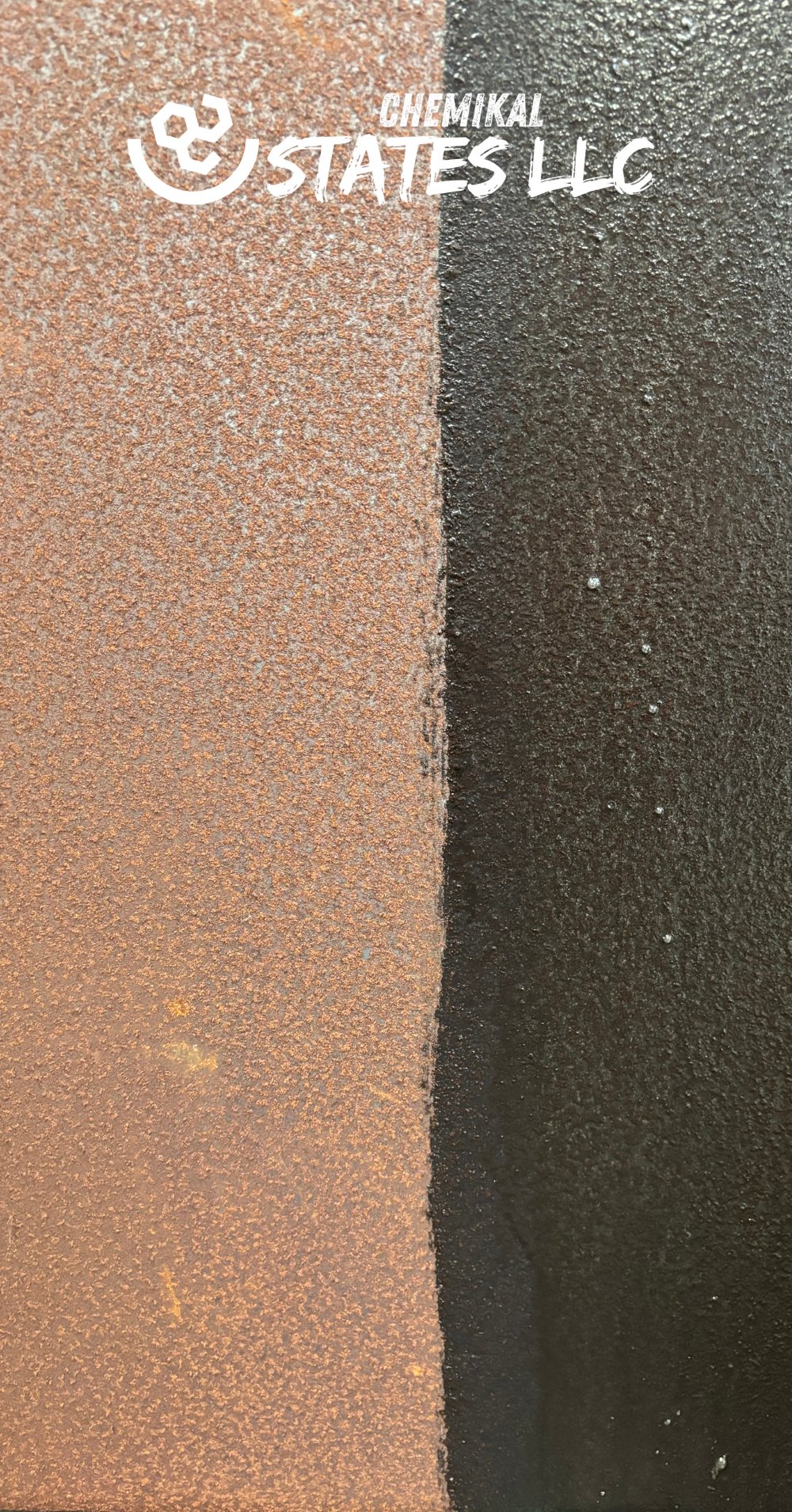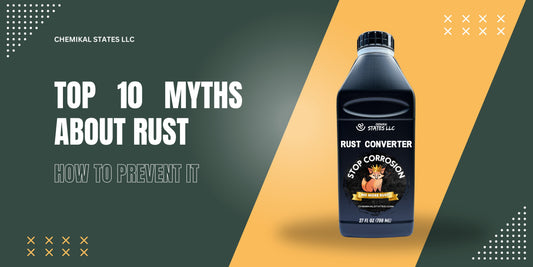
Best Rust Neutralizer for Trucks and Vans: Chemikal States Application Guide and Benefits
Share
Rust is one of the biggest enemies of any vehicle owner, especially when it comes to commercial vehicles like vans and trucks. Corrosion damage can lead to costly repairs, and in extreme cases, even pose a safety hazard on the road. That’s why it’s important to protect your vehicle in advance by using a proven rust neutralizer like Chemikal States.

Why Choose Chemikal States?
Chemikal States Rust Neutralizer is an advanced product that not only stops the corrosion process but also creates a protective layer, shielding the metal from further exposure to external factors. Thanks to its specially formulated design, Chemikal States penetrates deep into the rust’s structure, effectively neutralizing it and transforming it into a stable protective coating.
Application Method
1. Undercarriage with Rust:
- Before starting the application, thoroughly clean the surface to remove loose rust, dirt, and other contaminants.
- Then, using a brush, roller, or spray, evenly apply Chemikal States to the corroded areas.
- It’s important to ensure that the product reaches all crevices and hard-to-reach spots.
- After application, allow it to dry. Depending on weather conditions, drying times may vary.


2. Application in Closed Profiles:
- For closed profiles, it’s crucial to ensure the product reaches the interior where rust often develops unnoticed.
- Rust Converter can be applied using special spray probes that allow for penetration into hard-to-reach areas.
- It’s important to carry out the application thoroughly so the product can reach every nook and cranny, providing full protection.
Why It’s Worth It?
Chemikal States works exceptionally well in commercial vehicles like vans and trucks, which are particularly susceptible to corrosion due to heavy use and frequent exposure to moisture and road salt. Regular use of this rust neutralizer can significantly extend the life of your vehicle, which translates into real savings for your business.
Investing in Chemikal States is not just about avoiding costly repairs but also about increasing your vehicle’s resale value. A potential buyer who sees that maintaining the vehicle’s condition was a priority will definitely appreciate it during resale.
We Encourage You to Buy
With Chemikal States, you can be confident that rust will no longer be an issue. Easy to apply, long-lasting protection, and effectiveness proven by many satisfied customers make this a product worth having in your workshop. Take care of your vehicles today, and enjoy peace of mind knowing they’re protected by the best rust neutralizer on the market!
https://chemikalstates.com/products/rust-converter
Buy now and see for yourself how Chemikal States can improve your vehicle’s condition!
Useful Tips for Applying Chemikal States Rust Neutralizer
-
Thorough Surface Cleaning: Before applying the rust neutralizer, thoroughly clean the surface to remove loose rust, dirt, and grease. This will ensure better adhesion and more effective protection.
-
Apply on Warm Days: For best results, apply Chemikal States on warm, dry days. Humid conditions can extend drying time and reduce the product’s effectiveness.
-
Inside and Outside Application: Don’t forget to protect both external and internal parts of the vehicle, such as closed profiles or door interiors, where rust often develops unnoticed.
-
Use Protective Gear: When applying the rust neutralizer, wear protective gloves and a mask to avoid contact with the product and fumes, especially in enclosed spaces.
-
Additional Protective Layer: After the rust neutralizer has dried, consider applying an additional layer of paint or sealant to increase corrosion resistance and extend protection.
-
Regular Inspections: Even after applying Chemikal States, regularly inspect the undercarriage and closed profiles to detect any potential damage or new rust spots early on.
-
Ensure Deep Penetration: Make sure the product reaches all crevices and hard-to-reach spots. Using a brush or special spray nozzle can help get into those difficult areas.
-
Avoid Extreme Conditions: After application, avoid exposing the vehicle to extreme conditions (like mud, road salt) until the product has fully dried and formed a complete protective layer.
FAQ: Chemikal States Rust Neutralizer
- What is Chemikal States Rust Neutralizer?
- Chemikal States Rust Neutralizer is a specialized product that stops the corrosion process and creates a protective layer, preventing further rust development on metal surfaces.
-
How does Chemikal States Rust Neutralizer work?
- The product penetrates deeply into the rust structure, neutralizing it and transforming it into a stable protective layer. It acts as a barrier that protects the metal from further exposure to moisture, salt, and other corrosive elements.
-
What surfaces can I protect with Chemikal States?
- Chemikal States can be used on all metal surfaces prone to corrosion, both inside and outside of a vehicle. It is ideal for protecting undercarriages, closed profiles, doors, and other hard-to-reach areas.
-
How should I prepare the surface before application?
- Before applying the rust neutralizer, thoroughly clean the surface of loose rust, dirt, and grease. Using a wire brush or sandpaper can help remove larger rust fragments.
-
What are the best conditions for applying Chemikal States?
- The best results are obtained when applying Chemikal States on warm, dry days. Moisture and low temperatures can prolong drying time and reduce product effectiveness.
-
Can I use Chemikal States inside the vehicle, e.g., in closed profiles?
- Yes, Chemikal States can be used inside the vehicle, including closed profiles that are particularly prone to corrosion. Using special spray probes allows reaching hard-to-access areas.
-
How long does Chemikal States Rust Neutralizer take to dry?
- Drying time can vary depending on weather conditions, but it usually takes from several hours to one day. It is important to ensure proper conditions for the product to fully dry.
-
Can I paint the surface after using Chemikal States?
- Yes, after the rust neutralizer has completely dried, the surface can be painted or protected with another protective treatment, which further increases its resistance to corrosion.
-
How often should I use Chemikal States?
- It is recommended to regularly check the condition of the vehicle and apply Chemikal States as needed to prevent rust development. Depending on the conditions of vehicle use, the application can be repeated every few months to a year.
-
Is Chemikal States safe to use?
- Chemikal States is safe to use with the proper precautions, such as wearing gloves and a protective mask. It is also important to apply it in well-ventilated areas or outdoors.
-
Where can I buy Chemikal States Rust Neutralizer?
- Chemikal States is available in automotive stores, workshops, and online sales. You can easily order it and start protecting your vehicle against corrosion quickly.










